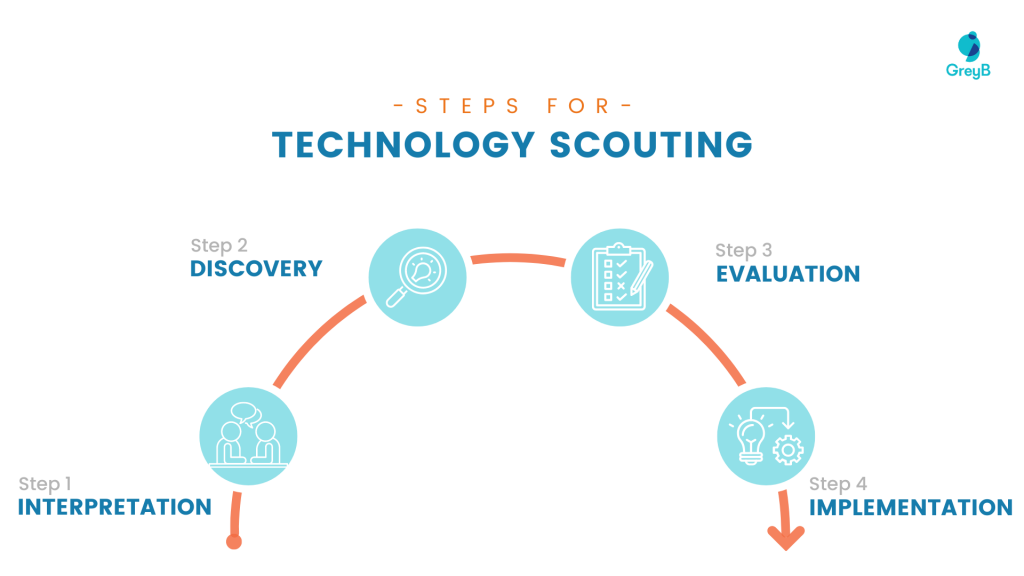Technology Scouting is the process of discovering, analyzing, and evaluating new or existing technologies that will help them with their innovation process. In simple terms, it is a process for companies to find the necessary technology outside the company. It is an important aspect of the open innovation strategy.
The economy is rapidly expanding, and new startups are entering the landscape. The key to staying competitive and holding onto market share in such a scenario is to constantly create new ideas. (It might be a goal for your company too.)
Not bringing innovations to the market can risk losing popularity, getting outdated, and eventually disappearing from the market. Remember when Nokia entered a little too late into the Android Revolution?
Despite the fact that there is an excess of accessible technology, many businesses still try to solve their problems by inventing new solutions rather than leveraging/ improving those that already exist. In the process, they waste a lot of time and money on solutions that they might have obtained in a more cheap and efficient way from other businesses. Eventually, all this research leads to no solutions at all.
That’s what happened with Mark. To discover a solution, Mark, one of our clients from a food-based company, contacted GreyB. Here’s how the conversation unfolded.
How Technology Scouting helped Mark find packaging solutions
“My R&D team is exhausted. It’s been months, and we still haven’t figured out a packaging solution for our lab-grown products. The deadlines are approaching, and we are at a loss for ideas!”, Mark told Rajesh in a panicky voice.
Rajesh: Mark, can you please explain the problem your team is facing?
Mark: We are looking for a biodegradable packaging solution for our lab-grown products. Furthermore, the material should be able to support its shelf life.
We were anticipating the launch of our new line of products. But the inability to resolve our packaging/shelf-life issue has completely thrown off our plans for the launch.
Rajesh: Did you search if there’s any other company solving this challenge?
Mark: We did look for vendors, but they either lack one-or-the-other requirements for our packaging needs or are unavailable. We might have to work on it in-house, but we don’t have the technology for it.
Rajesh: Well, in addition to competitive and landscape analysis, you should also look for possible technologies from other companies that can help enable your product. It’s called technology scouting.
A cliché but an ideal illustration is how NASA packs the solar panels on its satellites using the Japanese paper-folding art known as origami. The panels take up very little room in the cargo but grow to their full size once they are in the orbit.
The process of utilizing this knowledge and incorporating outside innovation into your business is possible through innovation or technology scouting.
Additionally, these “newly launched” startups/businesses may be of great assistance to you if you treat them as allies rather than competitors.
Today, thanks to open innovation, businesses have several possibilities for finding new ideas from other companies, if not from within the organization itself.
Technology Scouting is one such opportunity made possible by open innovation.
Mark: Well, it seems like my team could’ve explored a lot more areas had they followed this approach. But how do you know when to conduct technology scouting for a client? You can’t possibly go to such an extent for every project request!
When is Technology Scouting beneficial for you?
While, more often than not, tech scouting works in our client’s favor, we can’t follow this approach every time. But there are certain situations where Technology Scouting can become the right approach to follow. An efficient one, in fact.
Technology Scouting has proved to be an efficient choice if your requirements are as follows –
1. Save research time and resources while innovating
Making an invention from scratch requires a lot of work, time, and resources, and even then success is not guaranteed. As the other company has already put in the effort, adopting innovation ensures your success. Thus, saving you from the waste of resources. Moreover, your R&D may be busy with other projects, so it’ll be convenient to scout the technology to save time.
2. Maintain the competitive edge
With the expanding economy, new technologies are being developed on a daily basis. As a result, it is difficult for businesses that rely on old technology or solutions to prosper. By collaborating with other companies or startups, you include them in your company, thus lowering the market rivalry.
3. Get an early mover advantage
Rather than experiencing the try-fail cycle of introducing new technology from scratch, you can introduce innovations earlier than you thought possible. This approach not only attracts potential clients but also satisfies your existing clients as you will be the first to provide for their needs. Hence, helping you expand your clientele.
4. Get more time to focus on the product launch
Since innovating a technology from scratch involves a lot of experimentation, it takes time. Whereas, with technology being adopted from outside the company, you are left with a considerable time. You can now use this time to plan the launch of new products. Additionally, you can develop the best tactics to plan future policies.
5. Find technological assistance for R&D teams
R&D teams occasionally struggle to solve a specific problem because they lack certain technology that isn’t part of their core expertise. In this situation, Technology Scouting might serve as a link between several businesses that have the technologies you need. Therefore, giving your R&D a tech solution with little financial outlay.
If you have these goals in mind for collaboration, technology scouting is unquestionably what you require!
Mark: In that case, Technology Scouting is definitely what my business needs right now. So how do I go about scouting a technology?
Rajesh: Well, the Technology Scouting process involves four steps i.e. Interpretation, Discovery, Evaluation, and Implementation.
Let’s understand the steps shared by Rajesh in detail.
What are the steps involved in Technology Scouting?

Interpretation
Interpretation is the initial step in the Technology Scouting process. After determining the company’s technology requirements, the scouting process begins. Here, the question is whether they need a standalone technology or a technology that can be integrated into an existing system.
Let’s consider an example where one of our clients from the food industry was looking for an alternative protein for their cattle feed. Our team began the project by understanding the requirements and determining that the client required Technology Scouting.
Discovery
Finding a relevant company or business to work with can be like searching for a needle in a haystack. As a result, for the second phase, most businesses turn to Technology Scouting platforms for assistance.
The discovery phase entails looking for solutions by skimming the commercial offerings from a variety of companies or looking into ongoing research to judge the potential of custom development.
Continuing the previous example, the next step involved researching and selecting a variety of companies based on the requirements of the desired technology. As a result, we found that proteins like Canola, Barley, Corn, Alfalfa, etc as alternates for the client’s cattle feed.
Evaluation
Now that you’ve identified those who’d be able to assist you, it’s time to narrow down the solution that fits best your requirement.
Various parameters like carbon footprint, total digestible nutrients, geographical availability, etc. were considered to find solutions in the case of the alternate proteins.
The solutions were then ranked based on the requirements met by each one of them.
Implementation
After choosing the most appropriate solution from the final recommendations, the implementation process is carried out as the last phase. As part of the recommendations, various scenarios are considered, such as the need for quick collaboration, planning for the future, short-term or long-term investment, etc.
That’s how technology or innovation scouting enables businesses to implement ideas without wasting time or resources on innovating from the scratch.
Mark: While this four-step process sounds impressive, I’ll discuss this with my team.
Rajesh: Definitely! Will be looking forward to hearing from you.
How can GreyB help you with Technology Scouting?
GreyB’s consultancy will assist you in finding innovations from other businesses with the best solutions.
In several instances, our team of experts helped the client solve some key technology-related difficulties by identifying breakthroughs from non-competing companies and from other industry domains.
Here’s how we helped mark through tech scouting –
A European food & beverage company approached GreyB to help them identify biodegradable materials and companies that can help in achieving better packaging solutions for their products.
Along with providing the solutions, GreyB also evaluated the options to address the material weakness and checked for the commercially available options to enhance the material properties of food packaging.
As a result, GreyB created a list of 18 materials and recommended 2 out of those to pursue further.
In another similar project, a client from the packaging industry asked us to look into compostable packaging materials. Our team then looked for both established businesses and new startups to identify solutions to this issue.
We evaluated companies based on their commercial viability, sustainability considerations, etc, and then provided our clients the suitable options for collaboration.
Our experts at GreyB will conduct the scouting process on your behalf and provide you with the most relevant solutions.
You won’t have to spend time and effort browsing through extensive databases to find the advances your business needs! You got us. 🙂
Does Technology Scouting sound like it could solve your R&D team’s problem as well?
Authored By: Ridhima Mahajan, Market Research










